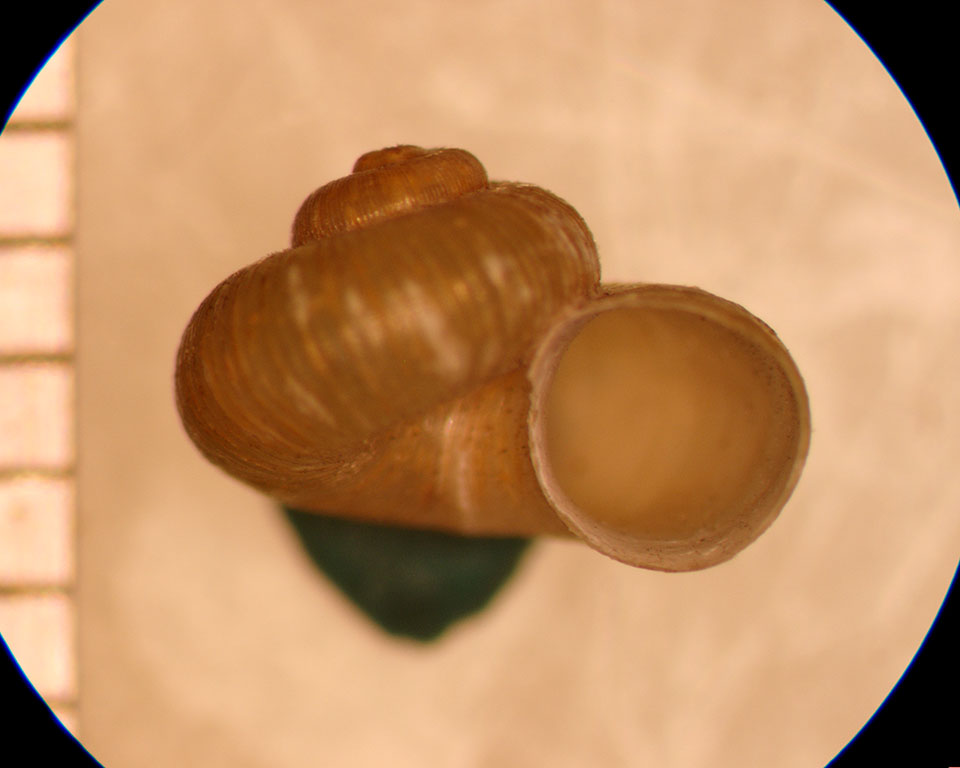
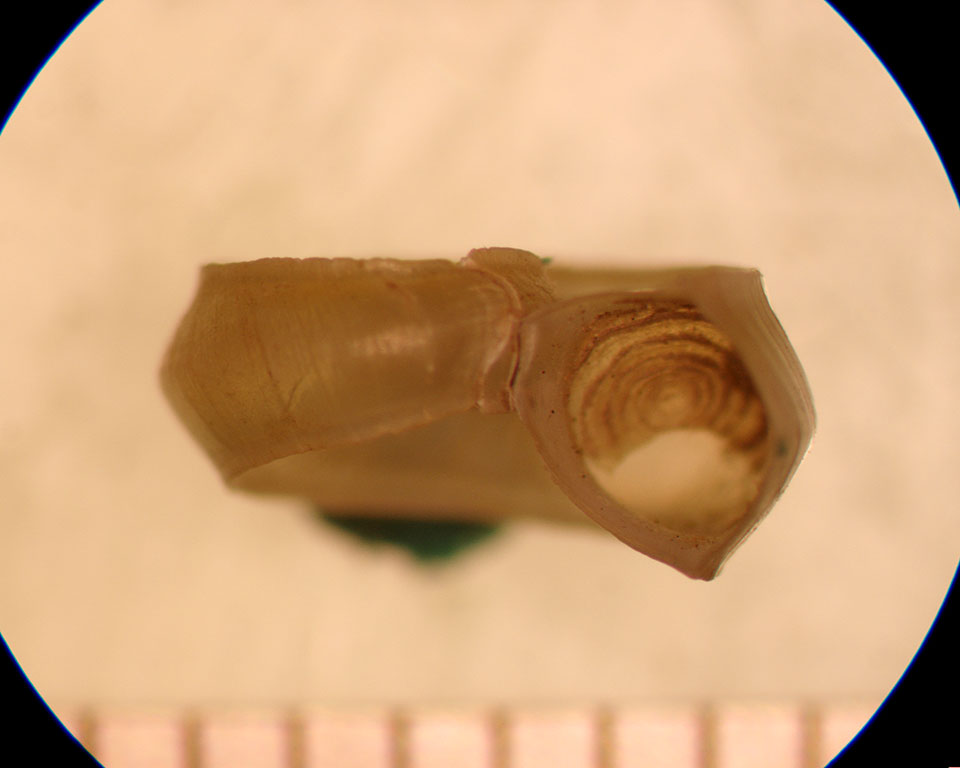
Key to Wisconsin Freshwater Snails
Developed by Kathryn E. Perez and Greg Sandland, based on previous key by J.B. Burch 1980.
Copyright notes: Unless otherwise noted, all images are copyright the University of Wisconsin La Crosse and taken by Chris Lynum. Shell drawings by Brittany Harried, modeled on images in Burch 1980.
Use of key: Taxonomy follows Turgeon et al. 1998, unless revisionary taxonomic work has been published since 1998. References provided at the end of this page. Also note that key is for adult individuals of extant species. Fossil species can be accessed via other keys. Snail vocabulary terms can be found in the glossary. Use of the key: The key begins with a few couplets to bring you to family of snails. Then separate couplets are for each family. If you already know family, go directly to that point. All shell photographs with a ruler have lines with an interval of 1 mm.
Additional useful pages: Key to the egg masses of WI snails, Comparison of difficult snails, Size comparison of juvenile Chinese mystery snails to other native snails.
Key to the freshwater snail families of Wisconsin
1a. Animal with an operculum (NOTE
- opercula may be missing in some specimens due to preservation methods, age of
specimen, etc; therefore it is important to use other morphological characters
in suspected cases) (2
2a. Shell small
(diameter up to 5 mm), spire generally
depressed, some species with carina,
operculum multispiral…Valvatidae
2b. Shell small to
large, spire depressed to elongate, operculum multispiral, paucispiral,
or concentric (3
2a. 

3a. Operculum multispiral or paucispiral, distal margins not concentric (4)
3b. Operculum
concentric (6
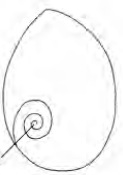
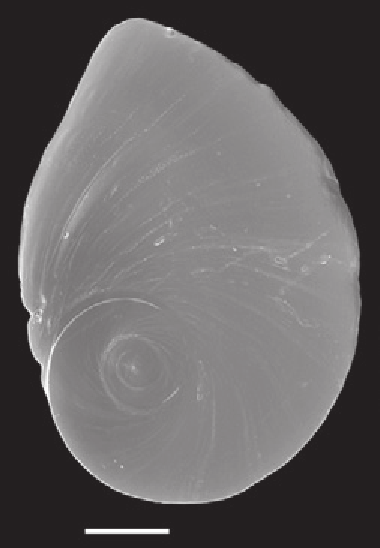
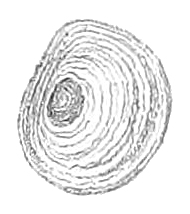
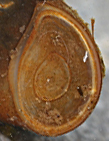
4a. Adult shell < 5 mm in length (5
4b. Adult shell medium,
to large (> 20 mm in length)...Pleuroceridae
5a. Shell high spired, turriform;
head-foot subdivided on each side by a longitudinal groove…Pomatiopsidae
5b. Shell high spired
to depressed; head-foot region lacking a longitudinal groove…Hydrobiidae
6a. Shells of adults
up to 15 mm in length; Operculum calcareous and concentric…Bithyniidae
6b. Shells of adults
medium to large (> 20 mm); operculum corneous…Viviparidae
7a. Shell coiled (8
7b. Shell not coiled;
cone-shaped (freshwater limpets)…Ancylidae
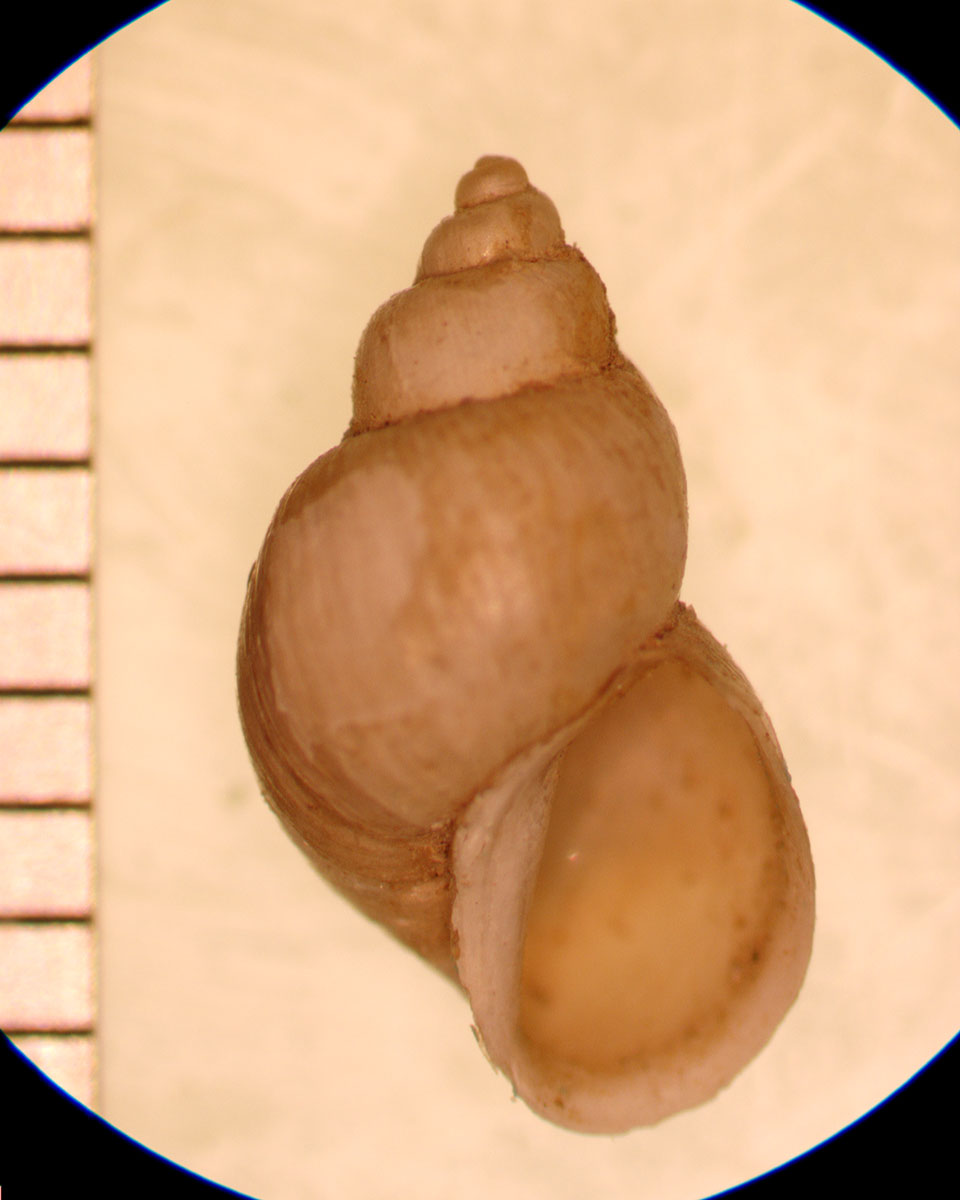
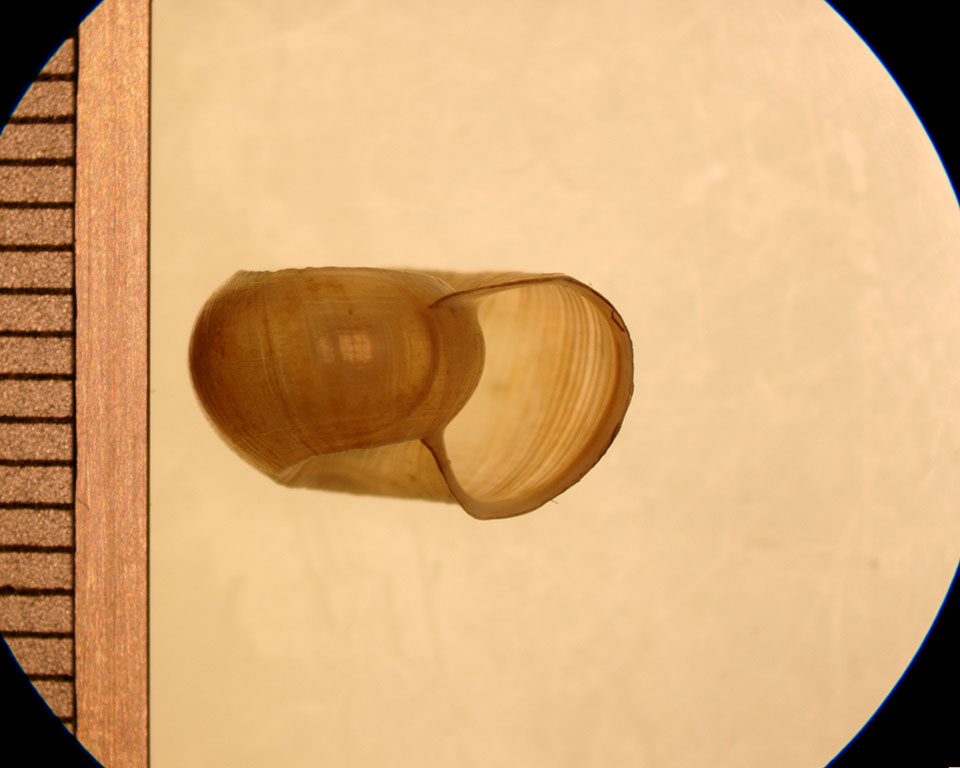
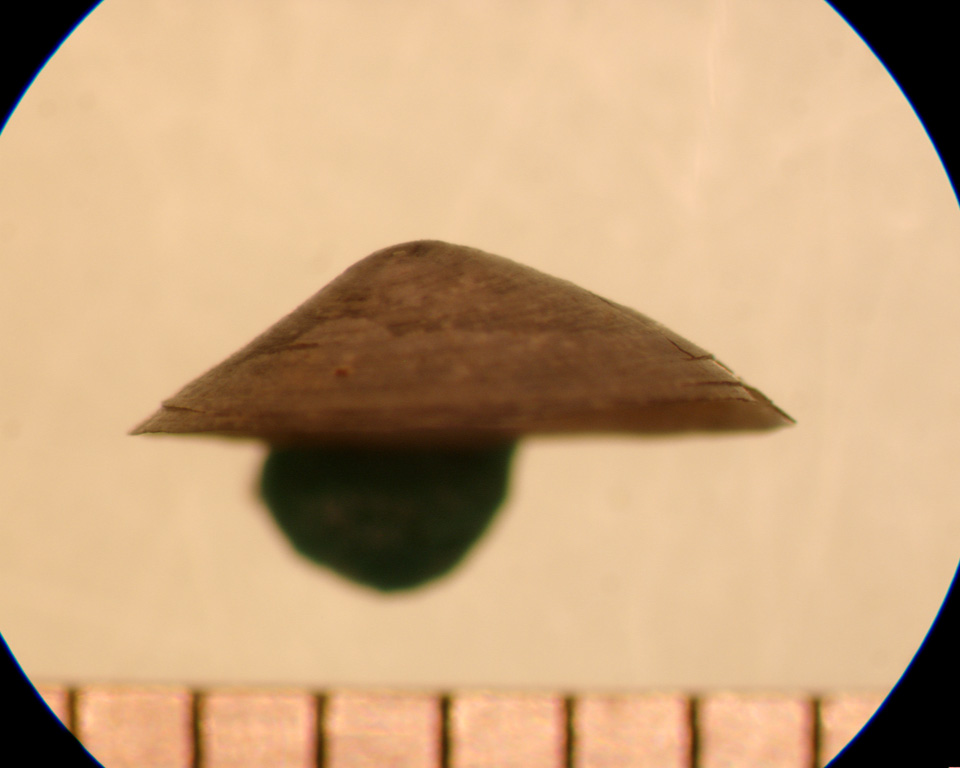
8a. Animal shell is dextral…Lymnaeidae
8b. Animal shell sinistral (9
 8b.
8b. 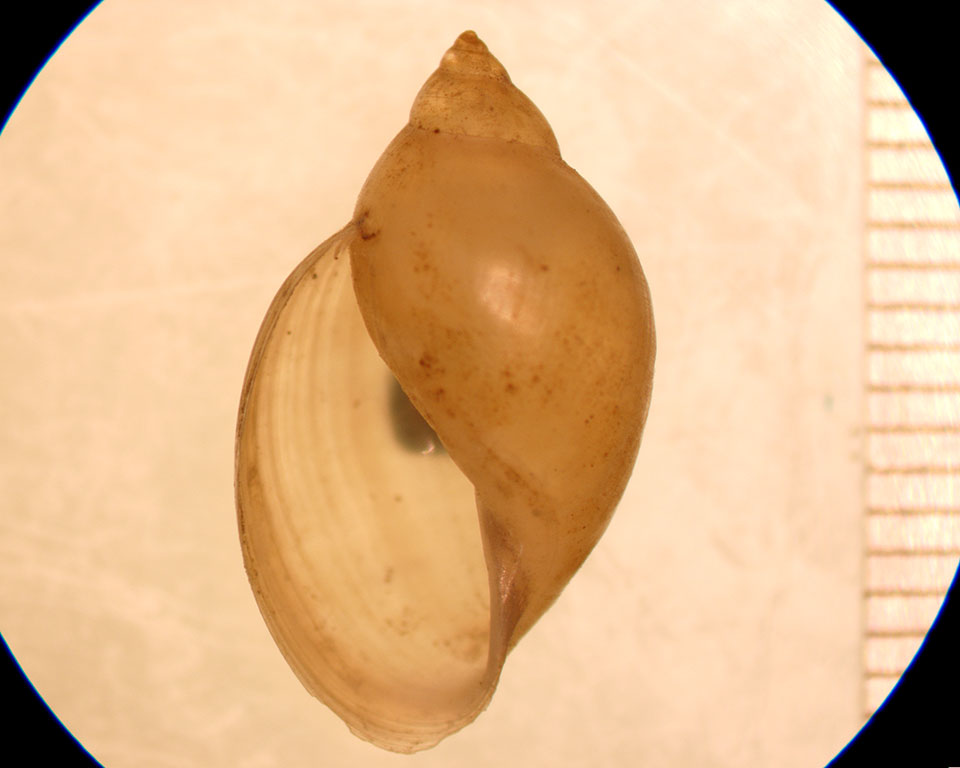

9a. Shell with raised
spire…Physidae
9b. Shell discoidal with
sunken spire…Planorbidae


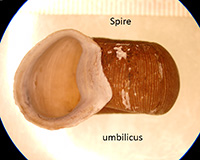
1a. Shell small, that of adults
< 8 mm in diameter…… Gyraulus and Promenetus
1b. Shell larger, that of adults > 8 mm and up to or more than 30 mm in
diameter... (7).
2a. Spire pit relatively wide.. Gyraulus
2b. Spire pit deep and narrow… Promenetus
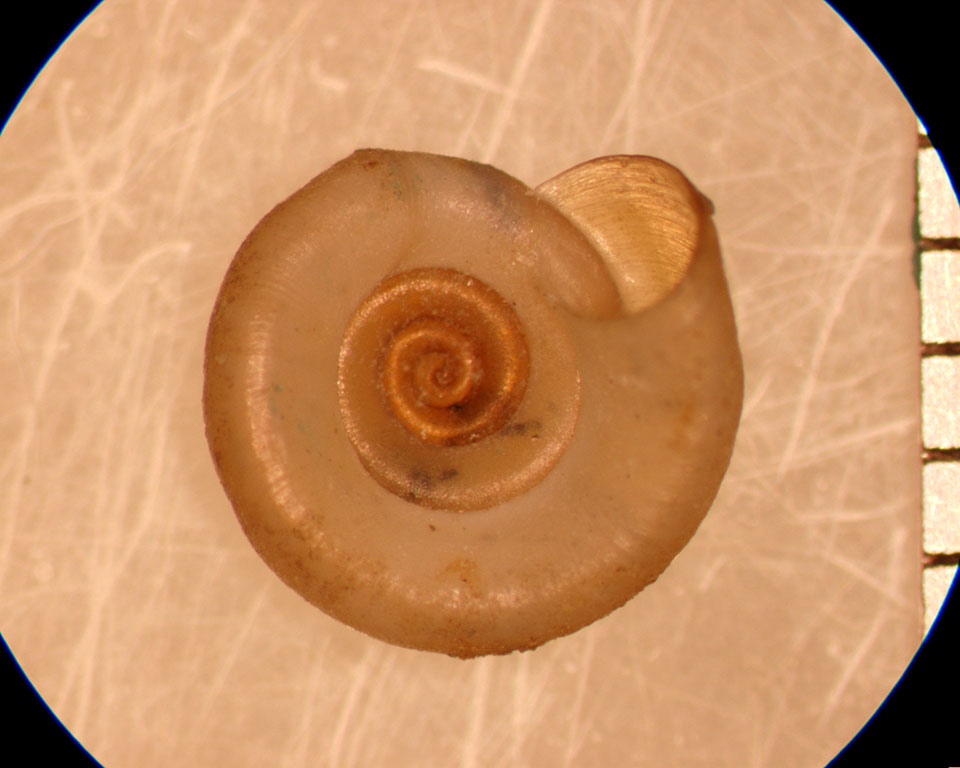 2b.
2b.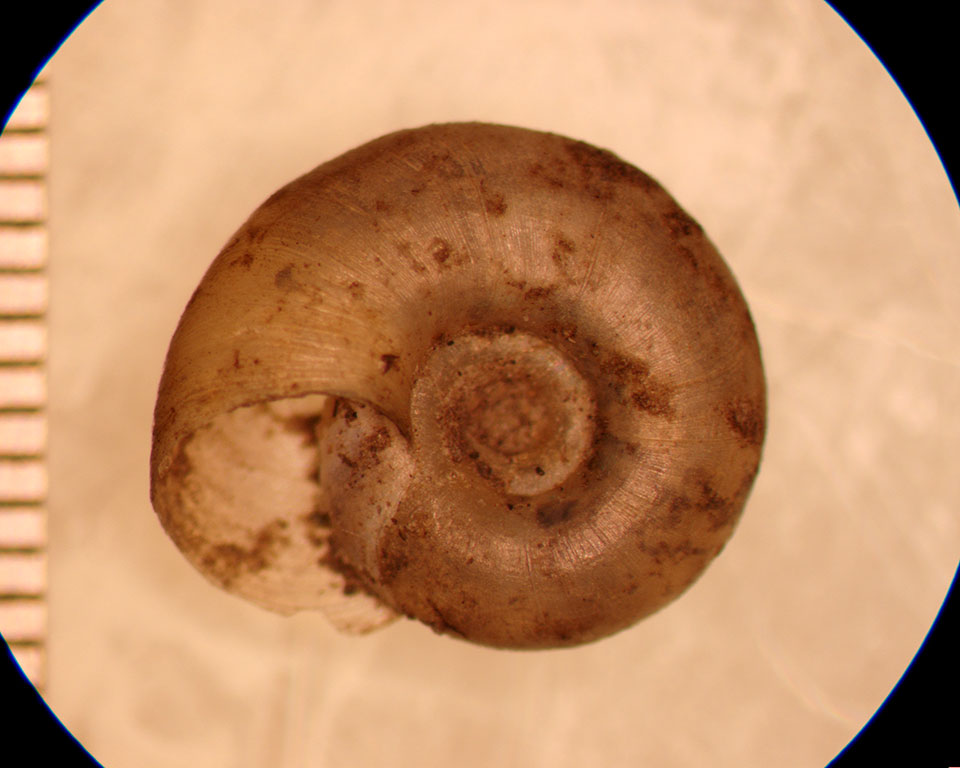
3a. Shell costate, having large surface sculpture... Gyraulus crista
3b. Shell not costate (4)
4a. Adult shells 4-7 mm in diameter, variable, with the body whorl not evenly rounded or with a peripheral keel or with a hirsute periostracum or a malleated surface, or these features combined... Gyraulus deflectus
4b. Adult shells 3-5 mm in diameter, variable with the body whorl evenly rounded or with upper lateral surface slightly flattered; without a peripheral keel, hirsute periostracum or malleated surface (5)
5a. Shell relatively high... Gyraulus
hornensis
5b. Shell relatively flattened, whitish or yellowish, semi-transparent, entirely or nearly planispiral, appearing almost the same from both sides... Gyraulus circumstriatus
6a. Shell with carinate periphery,
relative height of body whorl nearly equal from one side to the other... Promenetus
exacuous
6b. Shell with rounded periphery, relative height of body whorl increasing toward the aperture... Promenetus umbilicatellus
7a Inside aperture or body whorl
with “teeth” or lamellae... Planorbella
armigera.
7b. Aperture or body whorl without teeth or lamellae (8)
8a. Shell spire strongly
inverted, with a more or less conical depression; spire side of whorl with or
without a strong keel....Helisoma
anceps
8b. Shell spire not strongly
inverted, with a shallow depression, no depression or exverted (raised above
body whorl); spire side of body whorl rounded or angular... Planorbella (9)
9a. Body
whorl at shell aperture campanulate (flared)... Planorbella
campanulata
9b. Body
whorl at shell aperture straight, not campanulate. Shell surface usually dull,
rough in texture, with raised transverse thread-like striae.
(10
10a. Carinae or strong angulations present on the outer edges of both the right (umbilical) and left (spire) side of the body whorl of the shell. Shells small, those of adults less than 18 mm in greatest diameter, spire flat, not inverted or sunken into a bowl-like depression. (11)
10b. Carinae
absent, although a rather strong angulation might be present on the upper
surface of the body whorl of the spire. (12)
11a. Shells small, those of adults less than 18 mm in greatest diameter, spire flat, not inverted or sunken into a bowl-like depression, lines of growth more moderate, flattened...Planorbella truncata
11b. Shells large, very wide whorls, pronounced longitudinal sculpture, these lines of growth are distant, elevated, and conspicuous, giving surface a rough appearance...Planorbella binneyi
12a.
Inverted portion of the shell spire relatively wide, concavely smooth-sided and
bowl-like....Planorbella
pilsbryi
12b. Inverted portion of shell
spire narrower, generally not smooth-sided or bowl like....Planorbella
trivolvis
1a.
Anterior or “basal” end of aperture prolonged into a short canal, producing an
auger-shaped base to the shell. up to 10 whorls, sometimes whorls lighter
in color on the upper (closer to spire) portion of whorl. Aperture ~1/5 height of shell ... Pleurocera
acuta
1b. Anterior or “basal” end of aperture not
channeled or auger-shaped. ~5-7 whorls, uniform in color. Aperture ~1/3 height of shell... Elimia
livescens
1a. Shell
lacking postnuclear spiral carinae or
angulations (2)
1b. Shell
with one to three postnuclear spiral carinae or angulations (4)
2a. Shell
depressed-turbinate,
with spire slightly
elevated above the body whorl (3)
2b. Shell
high-turbinate or subconical, spire markedly elevated (5)
3a. Shell diameter > 5 mm, axial striae
lamellate; luster of shell dull... Valvata
lewisi
3b. Shell diameter < 5 mm, color of apical whorls usually dull purple, or violet, or pink. Luster of shell dull... Valvata perdepressa
4a. Shell depressed, with spire
barely visible above body whorl shell with 2 spiral carina or angulations, shoulder of
the body whorl sloping downward from the dorsal carina to the suture... Valvata
bicarinata
4b.
Shoulder of the body whorl sloping upward from the dorsal carina nearly to
suture, then turning downward... Valvata
winnebagoensis
5a. Umbilicus narrow,
no interior whorls visible, apex of
shell flattened appears truncated... Valvata
piscinalis
5b.
Umbilicus wider, may see interior whorls, apex of shell acute, shell diameter >5
mm, shell often pale green in color, may have fine axial striae... Valvata
sincera
1a. Shell large, adults >35 mm
and up to 55 mm in length, shell relatively thin, whorls not shouldered... Cipangopaludina (2)
1b. Shell
medium to large, generally less than 35 mm in length, but if large, the shell is
thick and ponderous, and the whorls are generally shouldered (the body whorl is
slightly flattened near where it intersects with the previous whorl) (3)
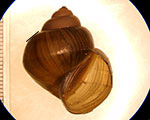 1b.
1b. 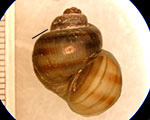
2a. Shell with acute spire, protoconch is
elevated, and usually with spiral angulations or low carinae on
the whorls; not malleated... Cipangopaludina
japonica
2b. Shell
with obtuse spire, protoconch flat, and without spiral angulations or low
carinae; generally with surface malleations, may have several spiral lirae on
body whorl, shell tends to be shouldered...Cipangopaludina
chinensis
3a. Operculum
concentric, but with a spiral nucleus; whorls commonly with a spiral
subsutural sulcus... Lioplax
sulculosa
3b.
Operculum entirely concentric, including its nucleus; whorls without spiral
sulci (4)
4a. Shell with or without spiral
color bands, width and length of aperture usually
nearly equal, making it round, or nearly so... Viviparus (5)
4b. Shell without spiral color
bands; length of aperture noticeably greater than width... Campeloma.
(7)
5a. Shell dark yellowish-green
to (usually) dark olive-green, without spiral color bands; shell broadly ovate,
whorls globosely rounded, spire obtuse... Viviparus
intertextus.
5b.Shell
pale olive-green to olive-brown; with or without spiral color bands, ovate but
not broadly so, whorls flattened
to well rounded, but not globosely rounded, spire relatively acute (6)
6a. Shell yellowish-brown or
olive-brown; color bands, when present, three in number, shell rather heavy,
whorls often flat-sided... Viviparus
subpurpureus
6b. Shell
yellowish-green or olive-green; color bands, when present, usually four in
number, shell relatively thin, but sturdy, whorls usually well rounded... Viviparus
georgianus
7a. Shell large, heavy, and
ponderous... Campeloma
crassulum
7b. Shell
medium or a little larger, relatively thin to strong, but not very large or
heavy and ponderous... Campeloma
decisum
General - Low, obtuse cap-shaped shells; often small in size with the shell apex offset
to the right; long thin tentacles. Freshwater
limpets
1a. Shell typically elevated
with fine radial striae on
apex. Aperture narrow
to broadly ovate (2
1b. Shell typically depressed with no trace of radial striae. Aperture
typically ovate to subcircular, smooth
with small raised riblets on
the anterior slope. Apex behind the
center of the shell...Laevapex
fuscus
2a. Shell to 7mm in length. Shell is robust, elevated and the aperture is elliptical. Apex in midline or slightly offset to the right. Anterior slope convex, posterior slope slightly concave. Calcareous material is often thick inside the shell... Ferrissia rivularis
2b. Shell depressed or moderately elevated; rarely exceeding 3.5 mm in length. With or without a shelf-like septum across the posterior part of the aperture. When non-septate, aperture is oval in appearance and wider anteriorly. When septum is present, the shell is evenly elliptical…Ferrissia fragilis
1a. Columella and parietal wall not thickened (2)
1b. Columella usually thickened (8)
2a. Shell rimate or imperforated (3)
2b. Shell umbilicated (4)
3a. Top of spire truncated; first several whorls coiled in the same plane... Probythinella emarginata
3b. Top of spire not truncated, first several spire whorls coiled in a descending spiral… Hoyia sheldoni
4a. Aperture broadly ovate to broadly ellipsoid… Cincinnatia integra
4b. Aperture simply ovate (5)
5a. Shell elongately conic (6)
5b. Shell typically ovately conic (7)
6a. Whorls rounded,
almost shouldered, sutures more deeply incised. Spire is rounded, aperture is
oval, apertural lip is reflected only slightly at base of lip. Fontigens nickliniana
6b. Compared to Fontigens nickliniana, whorls are less rounded, sutures less incised, spire is more pointed, aperture is not perfectly oval, draw up to a point into almost a teardrop shape. Aperture is reflected around most of the lip except at the very top. Often a brownish-reddish rim around the lip. U.S. populations will have brood pouch with developed embryos with eyes. Potamopyrgus antipodarum
7a. Protoconch punctate… Pyrgulopsis
lustrica
7b. Protoconch smooth (8)
8a. Nuclear whorl on shell relatively small (0.29-0.36mm in diameter), slightly protruding…Lyrogyrus*
8b. Nuclear whorl of shell relatively large (0.38-0.48mm in diameter) and flattened… Amnicola limosa
9a. Adult shell > 6mm in length… Birgella subglobosa
9b. Adult shell < 6mm in length (10)
10a. Shell
with a distinct umbilical chink; columella thickened… Somatogyrus
depressus
10b. Shell imperforate or rimate; columella with heavy callus forming a thickened continuous peristome… Somatogyrus tryoni
Note: *Although
two species of Lyrogyrus (L.
pilsbryi and L. walker)
were reported from Wisconsin, specific and reliable features used to
distinguishing these snails to species are not available.
General - Broad, flattened triangular tentacles. Dextral shells
that are coiled and tend to be elongated. Adult
shell with narrow or globose body whorl,
but if globose, the shell is well sculptured with small spiral striations.
1a. Shell attenuate,
very narrow almost needlelike… Acella
haldemani
1b. Shell
thicker, not especially narrow (2
2a. Shell succiniform (thin and fragile) with large oval aperture and body whorl, and small spire; surface sculptured with raised spiral periostracal threads… Pseudosuccinea columella
2b. Shell not succiniform, aperture
may or may not be large and oval, but if so, the shell is not thin or fragile,
and is not sculptured with periostracal threads (3
3a. Shell large, that of adults > 35
mm in length; shell with a wider, expanded elongately oval to globose body whorl (4
3b. Shell smaller, that of adults <
35 mm in length; shell with a relatively narrow body whorl (5
4a. Shell with a narrow pointed spire with
a large, subglobose body whorl... Lymnaea
stagnalis
4b. Shell with a relatively wide,
elongated spire; whorls not shouldered… Bulimnaea
megasoma
5a. Adult shell small (generally <
13 mm); typically lacking spiral sculpture. Columella generally
lacking twist (6
5b. Adult shell medium to large,
generally > 13 mm in length; surface sculpted with small spiral striations;
columella usually with a well-developed twist (11
6a. Adult shells with approximately 5 whorls, very small (< 7 mm in length) (7)
6b. Adult shells larger (> 8 mm in length), shell spire broad to narrow, but in shells with narrow spires, the spire length is not much greater than the aperture length (8)
7a. Whorls well-rounded, aperture roundly ovate… Fossaria parva
7b. Whorls distinctly shouldered, aperture elongately ovate or elliptical… Fossaria dalli
8a. Whorls regularly
or irregularly increasing in size, terminating in an elongate-ovate, sometimes
narrow body whorl. Pointed spire,
compressed body whorl, and elongated shouldered aperture.
Inner lip is appressed to the body whorl about the middle of the aperture… Fossaria
obrussa
8b. Shell
not as above (9
9a. Spire of
shell is long and the whorls are flatly rounded; very deep suture which
is almost channeled in some specimens causing the whorls to
become turban-shaped…..Fossaria
exigua
9b. Suture not as pronounced (10)
10a. Shell relatively slender; aperture more oval… Fossaria peninsulae
10b. Shell also slender, but aperture is more elongated; impressed inner lip where it joins the parietal wall… Fossaria modicella
11a. Possess an elongated, rather narrow brown shell (12)
11b. Possess
broader, light-colored shells with subglobose body whorls (14
12a. Shell quite narrow, flattened elongated whorls… Stagnicola exilis
12b. Shell
more elongately conic,
rounded body whorl (13
13a. Spire whorls long and acutely pointed; sutures deeply impressed; aperture roundly ovate… Stagnicola elodes
13b. Spire whorls short and blunt; sutures not particularly indented; aperture elongately ovate… Stagnicola winnebagoensis
14a. Spire as
long as aperture,
forming a narrowly acute pyramid (15
14b. Spire somewhat shorter that aperture, forming a wide short pyramid (16)
15a. Inner lip triangular, tightly appressed to columella; axis twisted and plaited... Stagnicola catescopium
15b. Inner lip forming flat, smooth shelf-like projection over columella; without plait... Stagnicola emarginata
16a. Spire acute, 1/3 the length of shell; aperture roundly ovate… Stagnicola walkeriana
16b. Spire depressed, broad 2/5 the length of shell; aperture elongately ovate… Stagnicola woodruffi
Note: Two
other species Stagnicola (S.
apicina and S.
caperata ) have been reported
from Wisconsin; however specific and reliable features for distinguishing these
snails to species are not available
General -
Members of this group can be distinguished from members of the Lymnaeidae based
on the fact that they have sinistral (left-coiled)
shells.
1a. Shell elongate, surface glossy (2)
1b. Shell subglobose with a short spire (3)
2a. Shell nearly spindle-shaped, spire long… Aplexa elongata
2b. Shell not as elongated, apex rounded… Physa fontinalis (image by Francisco Welter Schultes)
3a. Shell whorls are convex with deep sutures; spire is pointed; can reach 15 mm at maturity… Physella acuta
3b. Shell whorls have more flattened sutures; spire is conical; can reach 24 mm at maturity… Physella gyrina
Note: Physid shell features can be extremely variable among habitats and this has led to much taxonomic confusion in the past. The key presented here is based on recent physid phylogenies and descriptions by Pip and Franck (2008), Wethington and Lydeard (2007), Dillon and Wethington (2006), and Burch (1980).
Back to top of key
Acknowledgments
This project was funded by the Wisconsin DNR to assist with documentation of aquatic invasive snails and the native fauna of Wisconsin. Thanks go to UWL students Kyle Fischer and Brittany Harried for key testing. Brittany Harried contributed drawings of snails. The University of Michigan Museum of Zoology and the Illinois Natural History Survey both provided specimens to photograph.
References:
Baker, F.C. 1908. Note on Planorbis binneyi Tryon. The Nautilus 22-23: 41-41.
Burch, J.B. 1980, 1982, 1988. North American Freshwater snails. Walkerana Vol 1(3), 1(4), 2(6). 365 pp.
Dillon, R. T., A. R. Wethington. 2006. No-choice mating experiments among six nominal taxa of the subgenus Physella (Basommatophora: Physidae). Heldia 6: 41 - 50.
Hershler, R. 1994. A review of the North American freshwater snail genus Pyrgulopsis (Hydrobiidae). Smithsonian Contributions to Zoology, Smithsonian Institution Press, 115 pp.
Hershler, R. 1996. Review of the North American aquatic snail genus Probythinella (Rissooidiae: Hydrobiidae). Invertebrate Biology 115:120-144.
Hershler, R. and F.G. Thompson. 1988 Notes on morphology of Amnicola limosa (Say, 1817) (Gastropoda: Hydrobiidae) with comments on status of the subfamily Amnicolinae. Malacological Review 21:81-92.
Hershler, R., J.R. Holsinger, L. Hubricht. 1990. A revision of the North America freshwater snail genus Fontigens (Prosobranchia:Hydrobiidae). Smithsonian Contributions to Zoology, Smithsonian Institution Press, 49pp.
Hershler, R., L. Hsiu-Ping, F.G. Thompson. 2002. Phylogenetic relationships of North American nymphophiline gastropods based on mitochondrial DNA sequences. Zoologica Scripta 32:357-366.
Pip, E. and J.P.C. Frank. 2008. Molecular phylogenetics of central Canadian Physidae (Pulmonata: Basommatophora). Canadian Journal of Zoology 86: 10–16.
Turgeon, D.D., J.F. Quinn, Jr., A.E. Bogan, E.V. Coan, F.G. Hocherg, W.G. Lyons, et al. 1998. Common and Scientific names of aquatic invertebrates from the United States and Canada: Mollusks, 2nd ed. pp. 526.
Walther, A.C., J.B. Burch, D. O Foighil. 2010. Molecular phylogenetic revision of the freshwater limpet genus Ferrissia (Planorbidae: Ancylinae) in North America yields two species: Ferrissia (Ferrissia)rivularis and Ferrissia (Kincaidilla) fragilis. Malacologia 53(1):24-45.
Wethington, A. R. , C. Lydeard. 2007. A molecular phylogeny of Physidae (Gastropoda: Basommatophora) based on mitochondrial DNA sequences. Journal of Molluscan Studies 73: 241-257.
Errors, comments, concerns, or suggestions please send to perezke"at"gmail.com.